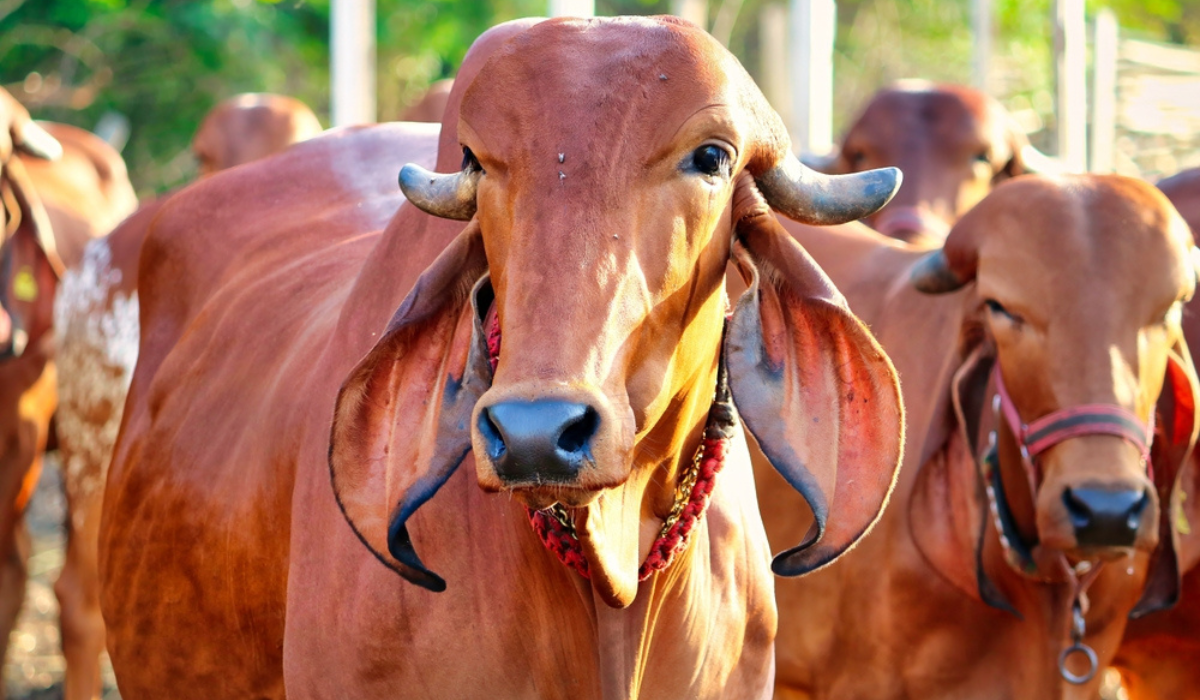The Gir Cow Breed, an indigenous breed from Gujarat’s Gir region, is highly valued for its exceptional milk production, rich nutrition, and resilience. This breed’s unique appearance—with a rounded forehead, long ears, and sturdy build—makes it easily recognizable. Today, Gir cows are prized not only in India but globally. Known as one of the best indigenous breeds for milk, the Gir cow supports India’s dairy industry by providing numerous health benefits and promoting sustainable farming.
The demand for pure, natural milk is increasing as people recognize its health advantages. Gir cow milk, rich in essential nutrients, is particularly beneficial for skin health, infant nutrition, and maternal wellness. In this article, we’ll explore the origins, characteristics, milk production, nutritional benefits, economic impact, and growing popularity of the Gir Cow breed in India’s dairy farming landscape.
Origin and Unique Traits of the Gir Cow
The Gir cow originates from Gujarat’s Gir Forest region and ranks among India’s oldest cattle breeds. Its unique appearance includes a prominent forehead, long ears, and a red or white coat, sometimes with dark spots. These features help Gir Cow Breed adapt to diverse climates, from humid to arid regions.
This breed is known for its calm nature, making Gir Cow Breed easy to handle on farms. Their robust build and endurance enable them to thrive under challenging conditions, making them an ideal breed for dairy production. Thanks to these qualities, the Gir cow is one of India’s top dairy breeds, valued for both productivity and resilience.
Impressive Milk Yield of Gir Cows
Gir cows produce large amounts of nutrient-rich milk. With proper care, a Gir cow can produce 10-15 liters of milk daily, and under ideal conditions, up to 20 liters per day. This substantial yield supports India’s dairy industry, especially in Gujarat, Maharashtra, and Rajasthan, where Gir cows are widely raised.
Gir cow milk fetches a premium price, usually between INR 70 and 100 per kilogram, due to its rich nutritional value. The milk has a fat content of around 4.5-5%, which gives it a creamy texture and makes it ideal for products like yogurt, butter, and ghee.
Nutritional Benefits of Gir Cow Milk
Gir cow milk contains essential nutrients like proteins, healthy fats, and vitamins, making it a top choice for natural dairy products. The milk’s high fat content provides a creamy texture that appeals to consumers looking for high-quality, wholesome dairy. Compared to milk from other breeds, Gir cow milk has a unique nutritional profile that supports immunity, bone health, and overall wellness.
Some benefits of Gir cow milk include support for infant growth, improved muscle strength, enhanced skin health, and a fortified immune system. Rich in calcium and phosphorus, it strengthens bones and teeth, while its proteins and enzymes aid digestion. Antioxidants in Gir cow milk also help reduce inflammation, making it beneficial for those with chronic conditions.
Potential Drawbacks of Gir Cow Milk
While Gir cow milk offers many benefits, it may not suit everyone. People with lactose intolerance may experience discomfort after consuming it, including bloating, gas, or digestive upset. For them, lactose-free milk alternatives may be a better choice.
Another factor is the milk’s high-fat content. Although beneficial for many, this may concern those on low-fat diets or individuals managing cholesterol levels. For these people, moderate consumption is advised, and consulting a healthcare provider may help balance dietary needs.
Economic and Environmental Impact of Gir Cows
Gir cows are a Cow Breeds In India due to their high productivity and nutritious milk. While mature Gir Cow Breed can be costly, younger or untrained cows are often available for under INR 50,000, allowing farmers to grow their dairy output over time. The daily maintenance cost of a Gir cow, covering feed, supplements, and veterinary care, typically ranges from INR 300 to 500. This investment is balanced by the high milk yield and premium price, making Gir cow farming profitable for many.
People who want to support Gir cows without buying them directly can do so through online cow donation platforms. These platforms allow individuals to contribute to Gir Cow Breed welfare while helping local farmers. Through these efforts, supporters preserve Indian livestock and contribute to sustainable farming practices in rural communities.
Spread of Gir Cows Across India
Gir Cow Breed have expanded beyond Gujarat to several other Indian states. Each region values the breed for its benefits to dairy production:
- Maharashtra has ideal conditions for Gir cow farming and a strong demand for nutrient-rich milk.
- Rajasthan values Gir cows for their resilience in arid climates, which suits the region.
- Karnataka and Madhya Pradesh raise Gir cows for their adaptability and productivity.
- Uttar Pradesh is also adopting Gir cows due to their hardiness and high-quality milk production.
In each of these states, Gir cows contribute to local dairy production, underscoring their role in the national dairy sector.
Final Thoughts on Gir Cow Milk
The Gir cow is a cornerstone of Indian dairy farming. Known for its resilience, adaptability, and high-quality milk, the Gir Cow Breed supports a sustainable dairy model that provides health benefits and economic returns. As awareness of natural and wholesome food sources grows, so does the demand for Gir cow milk, highlighting its value.
Gir cow milk, with its rich nutritional profile, is a valuable addition to a healthy diet. From supporting skin health to boosting immunity, Cow Breeds In India offers benefits for people of all ages. Whether used fresh or in traditional dairy products, Gir cow milk provides unmatched value, making it a preferred choice for health-conscious families across India.



